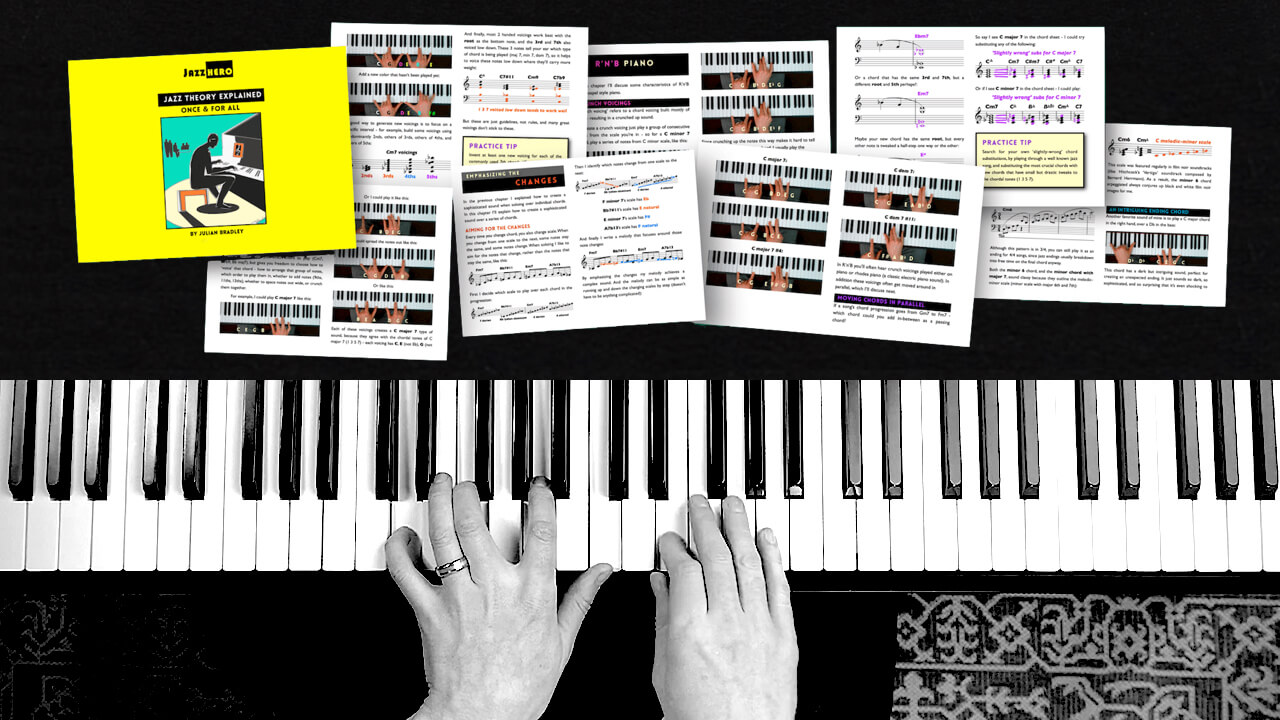Jazz Theory Explained E-Book
Are there gaps to your Jazz theory knowledge?
Here's some common signs:
-
"I lack confidence in my musical ability."
-
"I'm self-taught and never had formal training."
-
"I learn mostly on YouTube watching random videos in no particular order."
-
"I tend to switch topics whenever a lesson gets advanced."
-
"I learn through multiple teachers and have never stuck with one teacher to the end."
The real cause of 'Bland' Playing...
Before I learned Jazz theory, ALL of my playing sounded BLAND.
My compositions sounded bland (no matter how long I worked on them).

You see, if you don't learn Jazz theory - your playing can only sound bland, 'vanilla', and the same as everyone else.
It's learning theory that's the 'secret sauce' to sounding sophisticated.
That's what makes Jazz musicians stand out and sound way more interesting than any other style (in my opinion). It's that they know theory.
Learning Theory makes your playing sound sophisticated
You can't hide it when you know Jazz theory.
People can HEAR IT in your playing (even the non-musicians).
You clearly know what you're doing.
In fact, you'll never be able to compose anything complex until you learn Jazz theory.
Learn Jazz Theory from the ground up
Until recently, all of my Jazz lessons were scattered across hundreds of YouTube videos...
Everything was out of order, no structure, just random lessons.
So to organize all of my training in one place - I've written a complete e-book called 'Jazz Theory Explained - Once and For All'.
This book is 100 pages of concise step by step instruction, teaching you Jazz theory from the ground up.
Years of Jazz Lessons condensed into one book
I've condensed YEARS of my own Jazz piano education into one concise e-book - which you can race through in a matter of days.
'Jazz Theory Explained' teaches you much of what I teach across hours of YouTube videos - but it's organized in one place.

Just read it cover to cover and you should have virtually every question about Jazz theory answered.
I wrote 'Jazz Theory Explained' to give you complete confidence in your musical ability as a Jazz pianist.
Take A Look Inside
Swipe through the pages quickly and easily (works on any computer or device):
I've also included a 'Printer Friendly Version' which you can print to paper and take to the piano.
Throughout the book you'll find links to my best YouTube videos - organized by chapter. Just click on the links to watch them on YouTube.
Chapters in this book:
-
Part 1. Jazz Fundamentals: Scale degrees, interval counting, chord numbering.
-
Part 2. Introduction to Jazz harmony: Chord extensions, understanding a lead sheet, common chord progressions for Jazz.
-
Part 3. Jazz Scales: The chord / scale relationship, how to arpeggiate the chord symbol, aiming for the colorful notes, emphasizing the changes, exotic dominant 7 scales.
-
Part 4. Playing in different Jazz Styles: Walking Bass Lines, Bossa Nova, Cuban Jazz piano, Salsa.
-
Part 5. Advanced Jazz Piano Techniques: Melodic Embellishment, Reharmonization, Some of my Favorite Sounds.
"What will I Learn?"
-
"The Chord / Scale Relationship" - Learn this simple rule to figure out which scale to play over every chord (page 51).
-
Chord Extensions Explained - how to know exactly which note to add when you see 'b9', '#11', or 'b13' in a chord symbol (page 33).
-
Mental Shortcuts to quickly find your fingers to chords and scales (page 28).
-
My 21 favorite Jazz piano chord voicings Bring your playing to life with these! (page 44).
-
Discover the difference between 6 and 13 in a chord symbol (page 35).
-
Discover the difference between 4 and 11 in a chord symbol (page 35).
-
A neat trick to play the melody and your chord voicings at the same time (use this).
-
4 reharmonization techniques - add these to your repertoire and modernize your favorite standards (page 92).
-
Which notes to AIM FOR in your solos for MAXIMUM COLOR (page 56).
-
How to 'Emphasize the Changes' in your improvised lines (page 59).
-
How to end a jazz song in style using the minor 6 chord (page 97).
"Who is this book for?"
-
Piano players with 5+ years experience.
-
You have a PASSION to learn Jazz piano and you want to learn fast.
-
Must read music to an okay level.

This E-Book Comes With:

-
'Jazz Theory Explained' Ebook 100-page PDF (digital download).
-
'Jazz Theory Explained' Printer Friendly Version
-
YouTube Video Lessons, embedded in the text. Just click the links to watch.
-
Practice Tips throughout. No more guesswork.
-
Bonus 1. 30 Drum Tracks for playing Jazz Standards (includes Ballads, Swing tracks, Bossa Nova and more)
-
Bonus 2. '3 Emotional Jazz Pieces' by Julian Bradley (includes 'Dancing With You')
-
Bonus 3. 'The Jazz Piano Chord Voicing Guide'.
Value & Pricing
To cover this much training in private lessons would cost hundreds of dollars.
But with the 'Jazz Theory Explained' Ebook I'm giving you the same information at a fraction of the cost.
Get the 'Jazz Theory Explained' E-book for just just one payment of $35 USD.
That's less than the price of one in-person lesson with a piano teacher.
90-Day Money Back Guarantee
What if this book isn't right for you?
Not a problem - you have my 90-day money back guarantee.

If it's not right for you - just email me and I will fully refund your purchase.
Either you love it - or it's free!
What to do next
To claim your copy of 'Jazz Theory Explained' - just click the button below.
Fill out the secure order form and your download will begin immediately.
Your Jazz piano bonuses will be included in your download (drum tracks and Jazz piano compositions):
What Students are Saying:
-
"Terrific and easy to understand, what every visitor to your videos is praying for – a true GOLDMINE!” - Ray Huckell, (Toronto). 79 years old.
-
"I purchased your Jazz Theory Explained ebook and within 5 minutes knew that it was exactly what I’ve been looking for for years. Thanks for making all your hard work so accessible.” - Steve Schneider, USA.
-
“I bought your ebook and loved it! So much valuable information with detailed explanation. Your book is worth every penny!!!” - Mike Le.
-
“I am incredibly impressed with your easy clarity, your ability to convey complex material in an accessible and engaging manner, and your ability to focus on what’s really important in a logical fashion. - Steve Schneider, USA.
-
"I waited weeks before writing this email, because I wanted to see if your jazz theory book would clear up years of jazz theory confusion and frustration for me. Well, I’m happy to report that it has! Thank you so much!” - Roger Price, USA.
-
“Hey Julian, The book is fantastic! I have been taking ‘expensive’ Jazz Piano Lessons for almost three years. My technique has improved and I’m enjoying the lessons, BUT I gained tons of ‘understanding’ from just reviewing, what I thought I understood and reading your e-book. Keep the e-books coming!” - Ed Marsh, USA.
-
"When I decided to learn jazz piano 5 years ago, I searched high and low for a competent teacher who could lead me along the trail of developing a JAZZ SOUND. I lucked in to Julian Bradley on YouTube, watched every video he presented, made copious notes and went through the horrors of “oops, which video did he use to show his favorite major 7th voicing”. All of that is in the past as Julian has now published the most understandable explanation of the complexities of Jazz Piano and Theory. Terrific and easy to understand, what every visitor to your videos is praying for – a true GOLDMINE!” - Ray Huckell, Toronto.
Watch the 'Jazz Theory Explained' Trailer
Start Learning Now
To download 'Jazz Theory Explained', just click the button below.
Then fill out the secure checkout and your download will begin immediately.
Once downloaded, just open your Ebook and I'll see you in chapter one in a few minutes!
Have a question?
